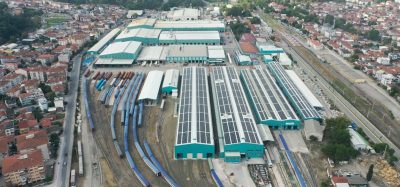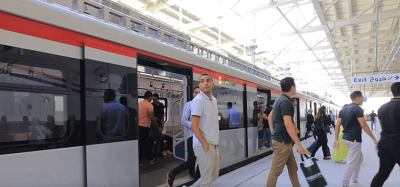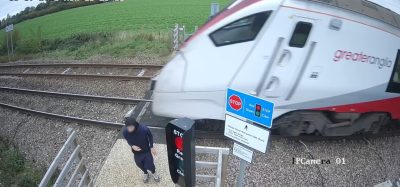Irish Rail’s 10-year asset strategy for user-worked level crossings
Posted: 14 October 2015 | Cathal Mangan | No comments yet
The Irish Rail network has a large number of user-worked level crossings which present great dangers. As Irish Rail’s Technical Manager Cathal Mangan explains, a 10-year plan has been developed to help improve safety and reduce risks at these level crossings.


The Irish Rail network is broadly radial in nature with main inter-city routes emanating from Dublin and, apart from double-track main routes to Cork, Belfast and within suburban areas, the network is extensively single line. It is also quite a rural network beyond the main suburban extents and as such, contains a substantial number of user-worked level crossings. These are interfaces where the user is required to operate the gates; there is no other system of control at these crossings and they fully rely on the user to ascertain whether it is safe to cross the railway. As such, they represent the biggest single infrastructural asset risk on the Irish Rail network. There are 721 of these crossings on the operational network currently across the three main types.
In 2013, in response to the on-going risk posed by this high risk asset category, Irish Rail developed a 10-year Level Crossing Asset Strategy which has the objective of improving safety and reducing risk through crossing upgrades, elimination, introduction of technology, standardisation, education and enforcement.
The strategy seeks to provide a framework for Irish Rail to develop and implement meaningful work programmes aimed at improving level crossing safety. The core of the strategy is based on the adoption of the following four key principles:
Join our free webinar: Rail cyber-security in a time of technological and regulatory transformation
Join our expert panel, including speakers from Nokia and Siemens Mobility, to explore the critical convergence of cybersecurity and 5G rail comms.
Date: 3 Dec | Time: 15:00 GMT
Can’t attend live? No worries – register to receive the recording post-event.
Principle 1 – Application of developments in technology and safe systems
One of the key drivers for change is that user-worked level crossings operate in a modern environment for which they were not designed nor are appropriate today. Modern, faster and more frequent trains are operating over live roadways where the expectation is for the road user to operate the level crossing gates and where the only means currently of alerting the user as to the presence of trains is their own visual check for this.
Warning system technology has been advancing continuously over the last number of years and such solutions are being progressed at user-worked crossings in a number of railway administrations. Irish Rail (IÉ – Iarnród Éireann) is looking to build on the technological advances in this area through utilisation of such systems, adapted to the specific characteristics of our rail network. It represents a cost effective methodology of achieving significant risk reduction at a greater number of crossings that would otherwise only be achievable through costly capital investments required for level crossing closures or upgrades.
Principle 2 – Risk-based prioritisation
A key principle adopted is for the prioritisation of all works based on risk. Irish Rail operates a Level Crossing Risk Model (LCRM) which is a live tool evaluating the collective and individual risk at all level crossings on an on-going basis. The LCRM requires the inputting of 120 characteristics for each level crossing which are determined based on a cyclic programme of inspections in line with Technical Standards. While the risk profile is constantly changing as risk changes, the LCRM is a key tool in allowing the identification of any intolerable risks as well as any evolving negative trends. The utilisation of the LCRM is important in ensuring that the application of resources and funding is targeted in the appropriate areas and where maximum benefit can be achieved.
Principle 3 – Engagement and enforcement
Communication on an on-going basis with the level crossing user is an important principle to be adopted. Such a high risk interface determines that this communication requires specific plans to target users and make them aware of the dangers of level crossings as well as their own responsibilities for the safe use of these.
Principle 4 – Standardisation
The diverse nature of the level crossing infrastructure that is in place and that has developed over the last number of decades is one of the contributors to the high risk associated with level crossings. The complexity of this diversity is compounded by the existence and utilisation of these user-worked level crossings in a modern environment with heavily trafficked public roads and modern agricultural activities utilising major farm machinery. The principle of standardisation of our level crossing infrastructure is therefore important so as to develop and improve the overall interface for the level crossing user and to ensure this interface is fit for purpose and appropriate for the usage requirements.
Five key strategic areas
These principles have given rise to the following five key strategic areas designed to provide a complete framework for the management of user-worked level crossings over the next 10 years:
- To develop and implement technological solutions at user-worked level crossings
- To implement targeted closures of level crossings on a cost effective basis
- To reduce the risk of collisions and near misses at level crossings
- To improve the safety culture and awareness both of internal and external stakeholders
- To implement standardised approaches to level crossing types.
-
Technological solutions at user-worked level crossings
A fundamental component of the 10-year strategy is the development of a warning system for user-worked level crossings on the IÉ network that provides the level crossing user with an appropriate alert as to the approach of trains and advises when it is not safe to cross. This system must have fail safe modes to further alert users that it is in degraded mode and advise the user on a safe course of action to take.
The overall principle of the project is the introduction of low-cost technological solutions so as to achieve a more widespread, and greater, risk reduction across a wider asset range than would otherwise be achievable by the capital intensive investment of other solutions (such as bridge provision or CCTV) at a smaller number of level crossings. Based on typical unit costs and compared with the capital investment requirement for the broader solution, it is estimated that the amount of total risk reduction that can be achieved via the implementation of low-cost technological solutions is a factor of 7–10 times that that would be achieved by targeting single or small numbers of crossings for capital investment. This strategy is particularly important in the constrained funding environment currently being experienced where there is a significant shortfall on the steady-state funding required.
Irish Rail are currently working with Schweizer Electronic for the design and implementation of these low-cost solutions through their proprietary ‘Vamos’ system.
-
Level crossings closures
Ultimately, the elimination of level crossings is always going to be the best solution to reducing risk. As financial constraints have curtailed major capital investments in elimination of crossings through provision of bridges, a comprehensive and detailed network review is being undertaken with a view to identifying opportunities for low-cost level crossing elimination. This can typically be through searches for split ownership of land entitling Irish Rail to close a level crossing, where low value property acquisitions can be made or where apparently disused crossings can be formally closed. This is a potentially high value for a low-cost programme of work. The project involves the close liaison between the Infrastructure Manager entity of Irish Rail with the supporting Property and Legal services.
Since the commencement of the strategy, significant progress has been made in this initiative in particular with field crossings where low value closures have been achieved throughout the network.
However, while this initiative will continue, it is anticipated that the rate of success will naturally decrease as all realistically achievable closures under this programme are achieved.
-
Risk reduction – collisions and near misses
The Irish Rail Network Wide Risk Model (NWRM) determined that train collision with vehicles at level crossings remains one of the single biggest accident types that contribute most to the overall risk on the rail network. This is in spite of improvements made over the last number of years as well as continued level crossing closures resulting in a 59% reduction in the prime risk since 2010. The NWRM output further determines that one of the areas with the greatest potential for safety improvements are at level crossings and this is in both the cases of prime and shared duty of care.
A number of serious collisions and near miss incidents have occurred on the network over the last number of years. To counteract these serious incidents, a key component of the 10-year strategy is a risk reduction programme for collisions and near misses. A specific programme for this element focuses on the highest risk areas with the development of a bespoke risk management plan on a crossing-by-crossing basis.
The output of this then leads to a series of relevant actions and interventions determined as necessary on a specific crossing-by-crossing basis. These can typically include road improvements, traffic calming measures, additional warnings as well as targeting of specific users involved in any incidents.
-
Improvement of safety culture
A two-strand approach is adopted under the 10-year strategy for the improvement of the safety culture at level crossings made up of engagement and enforcement.
Engagement focuses on positive communication efforts with level crossing users and stakeholders. Current examples of this include positive engagement via on-going publicity campaigns such as media campaigns. Other measures include the development of appropriate publications on safety at level crossings which have targeted distribution to level crossing users. Further engagement is undertaken through representation at relevant public events such as farming conventions and other local events. Media and modern communication methodologies are also being employed for the on-going reinforcement of the safety message and for the improvement of the overall safety culture.
Enforcement focuses on safety culture improvement through application of legal means. A targeted and proactive surveillance campaign, with a view to successfully obtaining prosecutions for abusers of level crossings, is carried out at those crossings where the level of abuse warrants this. The programme is carried out in line with all legal requirements such as data protection laws.
-
Standardisation of level crossings
Standardisation of level crossing types provides a more consistent interface for the level crossing user. Currently, that interface can be varied and so improvements in basic level crossing infrastructure at user-worked level crossings can greatly enhance the interface. Furthermore, these improvements can be achieved at relatively low-cost.
The typical works involved include installation of standardised warning signage, the provision of an adequate road surface to and from the crossing as well as over the crossing, the provision of adequate road markings, vegetation clearance to afford the user an adequate view of on-coming trains and general enhancements to the interface for the road user.
Success measures
Key to the achievement of the strategic objectives is to have meaningful work programmes associated with each objective with appropriate success ‘measureables’. These have been established and are monitored on an on-going basis.
The overall day-to-day implementation of the strategy is carried out within the framework of the Level Crossings Asset Plan which is an annual programme identifying the detailed work programmes in a given year. The purpose of the asset plan is to identify the safety, reliability, availability and maintainability issues that currently or will have a future impact on level crossing safety, and to develop strategies for each issue identified, with an accompanying programme of actions to ensure asset performance levels are maintained or exceeded including in line with the objectives and works associated with the 10-year Level Crossing Asset Strategy.
Biography


OUT NOW: The Definitive Guide to Rail’s Digital Future
The rail industry is undergoing a digital revolution, and you need to be ready. We have released our latest market report, “Track Insight: Digitalisation.”
This is not just another report; it’s your comprehensive guide to understanding and leveraging the profound technological shifts reshaping our industry. We move beyond the buzzwords to show you the tangible realities of AI, IoT, and advanced data analytics in rail.
Discover how to:
- Optimise operations and maintenance with real-time insights.
- Enhance passenger services through seamless, high-speed connectivity.
- Leverage technologies like LEO satellites to improve safety and efficiency.
Featuring expert analysis from leaders at Nomad Digital, Lucchini RS, Bentley Systems and more, this is a must-read for any rail professional.
Issue
Related topics
Infrastructure Developments, Level Crossings, Safety, Technology & Software







